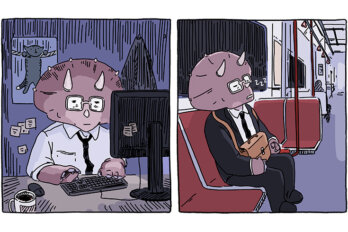When many of us packed up our desks at the beginning of the COVID-19 pandemic, we thought the lockdown might last a few weeks. Instead, some of the most significant aspects of our lives went virtual almost overnight—and stayed that way. After nearly two years of experiencing work, school, religious, and social events on screens, it’s strange to think how many of these adaptations have become second nature, revealing the various pros and cons of the life they replaced. In hindsight, I can’t believe how many forty-five-minute dashes I used to make across town to get to meetings and appointments and fitness classes. But I could live without ever celebrating another birthday over Zoom.
This fall, many of us were hoping to find ourselves going back to some kind of public life. With vaccination rates on the rise, there was room for cautious optimism even as the pandemic surged in Alberta and Saskatchewan and the Delta variant spread. Here in Ontario, which has experienced one of the strictest lockdowns in the country, we have learned to take a hesitant approach to planning. There were in-person events, but proof of double vaccination was often required. Kids were in school but sometimes back home in quarantine. Making any plans, there was a strong sense of inshallah—“if God wills it.” We speak of the “before time,” but what to call this limbo between the early pandemic and what comes after?
In this issue of The Walrus, we take stock of some of the technological changes the pandemic has furthered—in some cases, the switch to remote communication may have been inevitable, but that doesn’t mean the transition has been smooth. In our cover story, “Doctors on Call,” Carine Abouseif, a features editor at The Walrus, reflects on the rise of virtual health care: while remote appointments have benefited patients and health care practitioners alike, incompatible privacy legislation and mismatched technologies can create barriers to effective virtual care by restricting the sharing of health records. Abouseif’s story also demonstrates that, while virtual solutions may promise improved access to health care, sickness doesn’t respond to a one-size-fits-all approach.
Meanwhile, advocates for sexual assault survivors have long called for reform to the justice system, where tradition dictates that complainants must testify in person, facing the accused. In “My Day in Zoom Court,” a contributor writing under a pseudonym relates her experience within the virtual courtrooms made mandatory by the pandemic, arguing that preserving some elements of remote trials could improve the experiences of sexual assault survivors and the work of the justice system alike.
And, in “Neighbourhood Watch,” tech writer Navneet Alang describes one gentrifying neighbourhood’s increased use of community Facebook groups and personal-security cameras to keep “undesirable” people away from their deliveries. Obviously, as much as technology can bring us together, it has the power to split us apart.
It may be too early to know how much of the past two years’ worth of change is here to stay. When an architect recently provided a floor plan for the head office of The Walrus (which has been closed due to Toronto public health guidelines and is now undergoing renovations), my colleagues and I scrutinized it. But it was hard to “see” the reality of postpandemic life. The pandemic has changed us—not simply the way we work together but how we might use work stations and meeting rooms. After many months of communicating effectively, if distantly, on apps like Slack, what will “working together” mean?
As with so many things, the most obvious place to look for answers now is yet another screen. I was recently so struck by a scene from Ted Lasso that I watched it three times. In the second season, an episode ends with one of the characters stumbling into a nightclub. It took me a while to figure out why watching somebody dancing after an aggravating day was so affecting: the experience used to be common. And that’s just it. Right now, with danger still lurking in every face and invitation, we don’t have the luxury of losing ourselves in the crowd. Waving our arms in the air like we just don’t care—that’s one step forward I would welcome.





